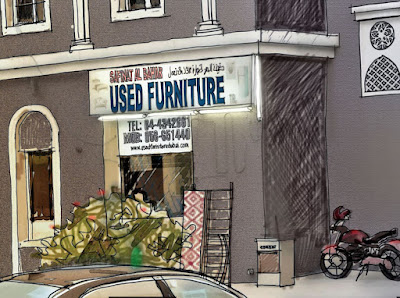I grew up with a pencil in my hand, drawing at every opportunity. Visual diagrams have always been my favourite approach to understanding any problem.
LINKS TO OTHER PAGES
BUILDING BOOKS DIGITAL DRAWING SQUATTING BOOK
SKETCHING SOANE
OVERVIEW
My father was an art teacher. He encouraged us to think visually from a very early age, supplied us with a variety of artists tools and materials, exposed us to the work of past artists. His paintings hung on the walls of the house I grew up in, and examples of his pottery were also dotted around.
This drawing is based on a photo I took in my late teens. It's a shop I used to pass each day on my way to and from Grammar School.
In 1980 I did a series of illustrations for a book called "Squatting, the Real Story" which was being compiled by some friends of mind from student days in London. By then I had returned to South Yorkshire and spent some years working as a bricklayer, but spent several weeks staying with them in Limehouse and drawing in a variety of styles.
Drawing and designing are two sides of the same coin, and I started trying to imagine buildings and parts of buildings in my early teens, continuing even during the years when I abandoned the idea of being an architect (my twenties and thirties) This sketch for a fireplace was done while I was working as a teacher and curriculum developer in Zimbabwe, five or six years after the squatting book adventure.
I spent my fortieth birthday in Johannesburg, a mature student at the School of Architecture, completing my academic studies so that I could register as an architect. I have to say that I took my studies much more seriously, second time around. My underground years in London had been more about discovering my self, exploring the freedoms of living away from home, testing the boundaries. This next image was part of a History of Architecture course that focused on Urban Design.
My thesis project was not particularly exciting but meant a lot to me at the time. This is a sketch I did as a facade treatment study. I was quite taken with the idea of a regional architecture suited to the local climate and economy that would help to forge a new Zimbabwean identity. Those were days of great optimism in my adopted country.
My first few years back in Zimbabwe after the Joburg interlude were quite difficult. My previous practice ditched me, then sued me to get back the money they had contributed towards my studies. Looking back I think there was rashness on both sides, and eventually we learned to forgive each other. But this pushed me into a more commercial practice than I had anticipated joining and exposed me to the white community in Zimbabwe to a much greater extent than before. Gradually I learnt to accept the "old Rhodies" as human beings who had just grown up in a very different environment from me. One of the first projects I worked on was a speculative scheme for a themed resort, very ambitious and it never went any further.
I really struggled to hold off the feeling that I was completely out of my depth in those early years. I'm really glad that I spent my youth as a builder and a teacher, but almost two years away from the profession meant that in my early 40s I was effectively a rookie, but expected to act like an experienced hand. That's how it felt, and it didn't help that my marriage was falling apart at the same time. Being a good father to my three children has always been hugely important to me, and I really worried about what would happen if we had to live apart.
I tried very hard to encourage my kids to draw and paint. Joe in particular was immensely gifted, producing a whole series of hand-crafted comic books with a hero named Dudey Sort
Things worked out well as it happened. Effectively I became a single parent with support from live-in grandparents. We had a large garden and a swimming pool, plenty of space for growing children and their friends to run riot at the weekend. Life was looking quite rosy for a couple of years, then Zimbabwe started to fall apart. Hyper-inflation kicked in and it got quite crazy, but still a good place for three teenagers approaching adulthood and flexing their wings.
.
Eventually I had to join the diaspora to earn hard currency for university fees, moving to Dubai in 2004. By this stage there was a strong digital component in my visual tookit. Here is one of my early attempts to use photoshop in a fluid and expressive way. It was a scheme for a tourism project, hotel bedrooms masquerading as Bedouin tents.
More recently I have tried to use digital sketching outside of my day job, trying to capture the urban reality of my daily life in Dubai. This is International City, perhaps the most affordable of the newly built suburbs, not so glitzy and polished as the Dubai that most tourists see, but bustling with life and constantly changing.









No comments:
Post a Comment